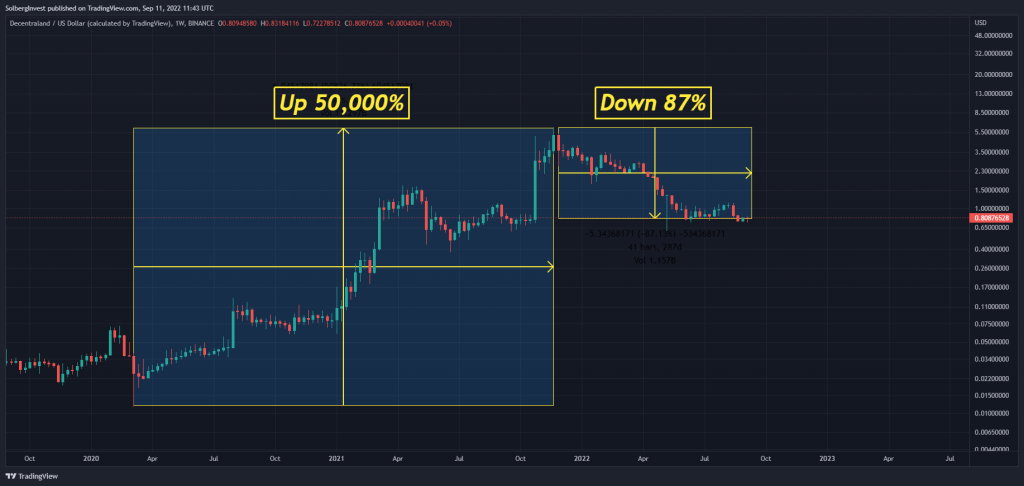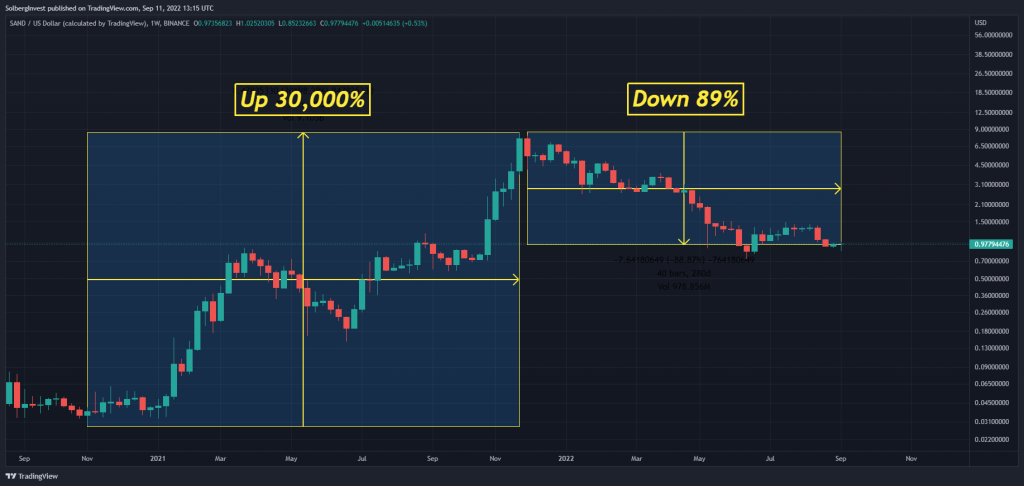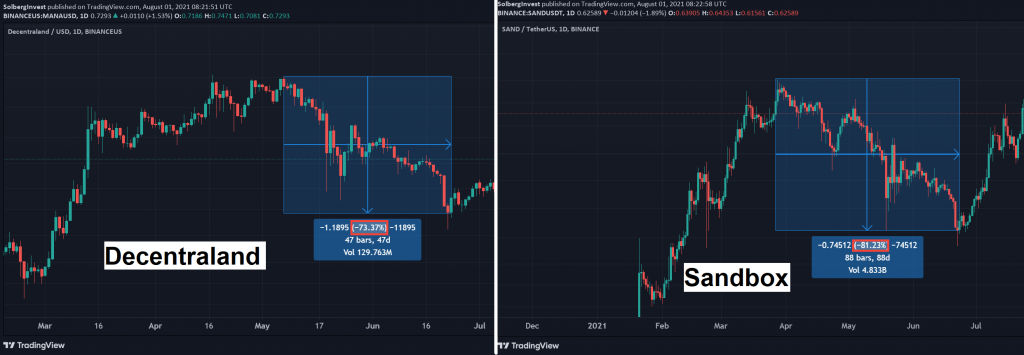(Updated 11. September 2022)
I’m a big fan of “metaverse” projects like Decentraland and The Sandbox. I think they have a mind-bending high potential for creating value, both for investors and players. In this article, we’ll look at Decentraland vs The Sandbox in terms of games and investments.
Here’s the short version:
The Sandbox has higher potential returns but is riskier. Decentraland is the better investment for long-term holders, as the risk is lower, and the adoption of the game, which is the most important factor, has come further than for The Sandbox.
I’ll back my claims with data and numbers in this article, and expand on the reasons why I believe Decentraland is better than The Sandbox.
Is Decentraland Better Than The Sandbox?
To get an idea about which of Decentraland and The Sandbox is better, I have included a detailed comparison in the following section.
Let’s first get to know each of the two projects:
The Sandbox
The Sandbox platform came into existence in 2011. It’s a gamer-friendly metaverse that utilizes blockchain for the involved players to contribute to its development.
Using The Sandbox, players can create and collect blockchain-based assets.
It has a powerful Voxedit graphic editor used with the Game Maker to create a variety of graphical content.
The co-founder of Pixowl, Sebastien Borget, is The Sandbox COO with Arthur Madrid, CEO at Pixowl.
The cryptocurrency associated with The Sandbox is used for various functionalities like buying, trading, playing, earning, and governing the platform. It’s called SAND.
The Sandbox uses Non-Fungible tokens (NFT) for securing ownership and monetizing the content developed within their metaverse.
According to the company’s 2020 review, their map value increased 5x and they sold $20+ million worth of virtual LAND (digital real estate).
There has been some development in releasing a new MMORP gaming world for an enhanced gaming experience. Over 100,000 registered accounts play within this metaverse along with exclusive Smurfs, Atari, and Binance NFTs.
More on the adoption of this project later in the article! Let’s move on to Decentraland.
Join my newsletter:
Get technical analyses and reviews/guides about Bitcoin and Altcoins for free!
Decentraland
Decentraland is the go-to blockchain virtual reality platform for newbies because of its general simplicity and easy-to-use builder tool.
Decentraland’s platform is not governed by any central authority, but by the Decentraland DAO (Decentralized autonomous organization).
This means that every holder of the governance token MANA owns part of Decentraland, and can participate in the governing of the metaverse.
You don’t need to be a developer to create content in Decentraland. If you want to learn how to buy land (Parcel) or how to build in Decentraland, I’ve written articles about that. It’s easier than you think!
There is also the option of an advanced SDK, which gives you more control and options. This is suitable for those who want customizations and know some programming.
This platform is built for content creators, businesses, and individuals interested in artistic mediums as a source of entertainment or as a developing business opportunity.
There 3 kinds of assets available in this ecosystem, namely MANA, LAND, and WEAR.
All the asset types are NFTs, giving you the possibility to trade them with other players in-game or outside the game on various online marketplaces.
Decentraland was the brainchild of Ariel Meilich and Esteban Ordano, who founded it in 2017, but they stepped down and not currently leading this project longer.
I’ve written more articles about Decentraland you might want to check out:
Does Decentraland Have A Future?
Can Decetraland (MANA) Reach $100?
Decentraland vs The Sandbox: Which Is A Better Investment?
From an investor’s point of view, both Decentraland and The Sandbox seem good prospects if you want to invest in “the metaverse”.
For the rest of this article, I’ll look at adoption, historical data, and the future growth potential for each of them to pick which one to invest in.
The Adoption Of Decentraland
The Decentraland community is growing fast, reaching many milestones in the past year. The growth is accelerating due to lockdowns all over the world-leading people to spend more time online.
According to Ari Meilich (co-founder of Decentraland), the platform has over 300,000 monthly active users. (source)
In addition to regular user adoption, Decentraland has become the “metaverse of choice” for brands looking to promote themselves. However, this is quickly being challenged by Sandbox. More on that later!
Brands like Coca-Cola are entering the NFT space and dipping their toes into Decenetraland as well:
Coca-Cola has made several NFT items you can buy and use in Decentraland. You can buy a mini-fridge with cola and other drinks and drink them in your digital house in Decentraland. There’s even the sound of a bottle opening and the fizz of carbonated water. (source)
Decentraland has also evolved into a place to have meetings, not just social ones, but also business meetings. For instance, Consensys (a group of huge companies including JP Morgan and Santander), have had meetings in Decentraland. (source)
Even Samsung has joined Decentraland, setting up their first digital store called “Samsung 837X”. In the store, players of Decentraland can participate in an adventure to win badges (NFTs) and more. (source)
Summarized, we can say this:
Decentraland has a growing base of more than 300,000 active users as of late 2021 and has gotten institutional attention from big names like Coca-Cola, Samsung and Consensys. This will likely accelerate, as the value offered by this platform increases exponentially with each new user due to the network effect.
The Adoption Of The Sandbox:
The Sandbox offers players to build its virtual world pixel by pixel, where you can convert anything you create into an NFT.
This NFT can then be sold either in-game or on exchanges/platforms like OpenSea.
This leads to much more customization and freedom for the users of The Sandbox vs in Decentraland.
While comparing these two projects and their features, one must note that Decentraland uses only the ERC-721 standard, whereas The Sandbox plans to support and implement the ERC-1155 standard in the game in collaboration with Enjin, including the ERC-721.
(Suggested reading: Decentraland vs Enjin)
This makes The Sandbox compatible with additional tokens, leading to more diverse NFTs available in-game. This gives developers more freedom, which might be enough to gain a competitive edge against Decentraland.
As mentioned earlier, Decentraland offers LAND, MANA, and WEAR.
In The Sandbox, you’ll have the ability to use, trade, and monetize much more than three different NFTs once Enjin makes this possible.
Enjin is an interesting project that you definitely need to have on your radar. Check out this article where I go into detail on the future of Enjin.
The Sandbox lags behind Decentraland on users. They have a total of 500,000 users as of Q4 2021, while the number for Decentraland is estimated to be in the millions. (source, source.2)
Another interesting thing to compare is the volume of trading on Opensea (the leading NFT marketplace):
- The Sandbox has a lifetime volume of 143,621 ETH.
- Decentraland has a lifetime volume of 342,715 ETH
In other words, Decentraland NFT’s have been traded roughly three times more than that of The Sandbox. However, we need to keep in mind that Decentraland has been up and running much longer than The Sandbox.
As promised earlier in the article, below you’ll find some of the partnerships The Sandbox has landed:

In addition, they have hosted some pretty cool events, like a concert with Deadmau5. and Snoop Dogg. (source)
All things considered, Decentraland has more addition than The Sandbox. However, this might change in the future if The Sandbox keeps up its good work.
Furthermore, the customization and freedom offered in The Sandbox vs in Decentraland might be enough to flip the scales in the long run.
Historical Performance Of MANA and SAND:
Let’s look at the historical performance of the two projects in terms of price since the September of 2020.
Decentraland (MANA) Performance Since 2020:
Decentraland (MANA) increased by more than 50,000% in the bullish part of the current cycle, but crashed almost 90% thereafter:

This is a great performance. A thousand dollars invested in Decentraland in March of 2020 would turn into half a million dollars in November of 2021.
That half a million dollars would then shrink to $65,000. All moves considered, that’s a 65x gain in a little more than two and a half years.
Let’s look at the performance of SAND and compare them:
The Sandbox (SAND) Performance Since 2020:
The Sandbox (SAND) increased by more than 30,000% in the bullish part of the current cycle, but crashed, like MANA, almost 90% thereafter:

The surge equals an ROI of 3,000x, meaning that $1000 invested in Sand in November 2020 would turn into $300,000 in November 2021!
I measured the move from November instead of March since SAND wasn’t launched until later in 2020.
It later crashed by 89%, turning that $300,000 into $33,000
The fact that The Sandbox is a smaller project, however, means that it has higher potential returns for the future. After all, it’s easier to double the size of a small company than a large company.
How Well They Do In Mid-Cycle Corrections:
After the bull run in Q1 and parts of Q2 in 2021, the market turned on us. Let’s look at how Decentraland performed in the downturn vs how The Sandbox did:

Looking at the charts above, you see that Decentraland is the winner of the bearish moves in the bullish markets.
Decentraland corrected with 73.37%, while The Sandbox corrected with 81.23%. It’s not a huge difference, but those few percentages really matter.
Here’s some interesting math about how much increase is needed to get back to the pre-crash price:
| Project | Corrected With: | Multiple Needed to Get Back |
|---|---|---|
| The Sandbox | 81.23% | 5.32x (432% surge needed to bounce back) |
| Decentraland | 73.37 | 3.75x (275% surge needed to bounce back) |
Also, Decentraland managed to turn the trend around after 47 days, while The Sandbox didn’t start trending back up until 88 days had gone by.
The main reason for that seems to be the fact that The Sandbox peaked in March, while Decentraland peaked in May.
And the takeaway from the images above is this: Decentraland is less risky compared to Sandbox, if history is any indication.
PS: I have a free newsletter where I send out technical analyses on Bitcoin, Ethereum, Cardano, Sand, Mana, and more. Also, I’ll give you helpful guides and reviews.
Get expert insights every week – Sign up for free below:
Conclusion: Decentraland Is Better Than Sandbox
They’re both great, but Decentraland has more adoption than Sandbox which is the key to success in the cryptocurrency market. Also, Decentraland is less risky to hold, to some degree justifying the lower potential returns it has compared to Sandbox.
If you’re more of a speculator, The Sandbox is better for you, as the potential returns might be higher. Personally, I think there is more untapped potential in The Sandbox than in Decentraland.
To be perfectly transparent, I hold both in my portfolio. If you want to follow my trading strategy, join the premium newsletter:
Grab My Free Guide – Increase Your Returns!
When investing in cryptocurrencies, there are sneaky ways to multiply your returns significantly. I’ve written about four of them and given them to you FOR FREE in this guide:

